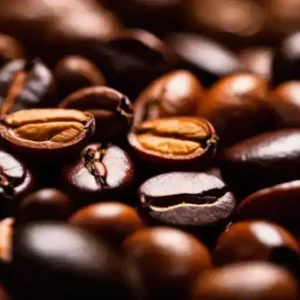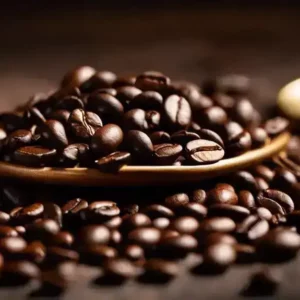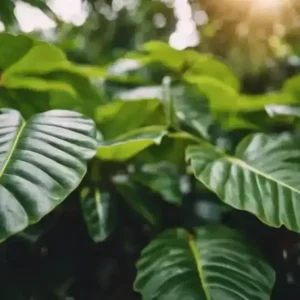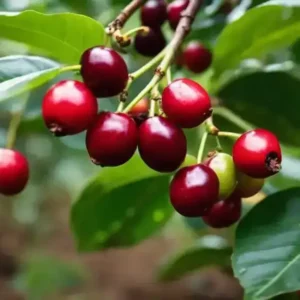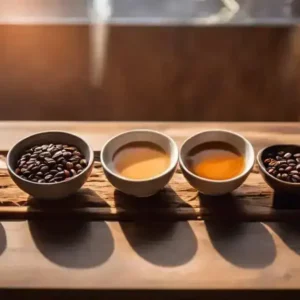When choosing between Robusta and Excelsa coffee beans, consider their distinct characteristics. Robusta boasts higher caffeine levels, disease resistance, and earthy-chocolatey flavors, ideal for blends and instant coffees. On the other hand, Excelsa offers a fruity-tart taste, grown in Southeast Asia at medium altitudes.
Robusta suits espresso lovers with its bold profile, while Excelsa’s unique flavors shine in pour-overs. Market-wise, Robusta dominates blends for its bold notes, while Excelsa appeals to those seeking exotic flavors.
For a personalized brew, understanding these beans’ nuances is key to perfecting your coffee experience. As a seasoned barista with over a decade of experience in specialty coffee, I can guide you in choosing the perfect beans for your preferred brewing method.
Robusta Coffee Beans
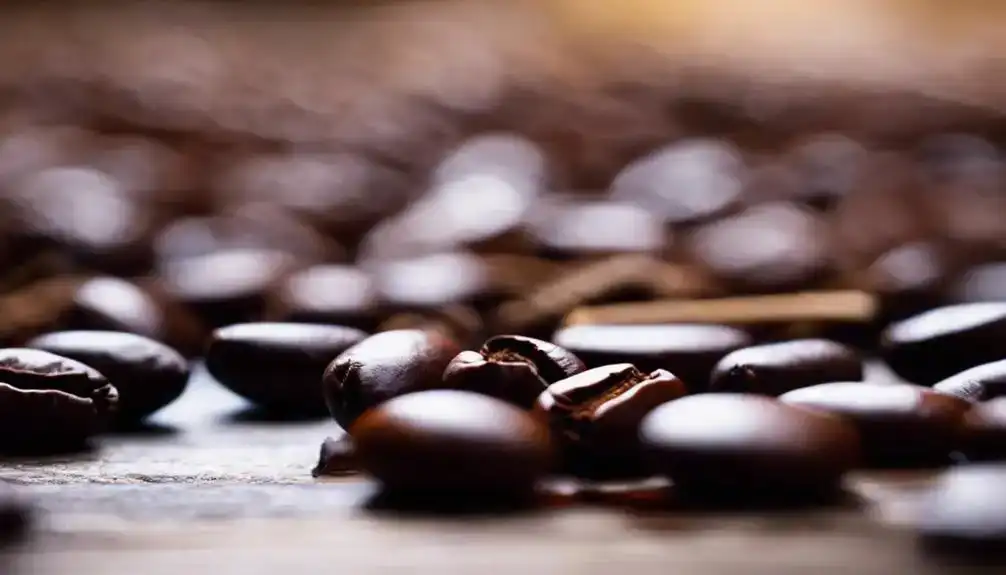
Robusta coffee beans are known for their bold and bitter taste. They contain higher caffeine levels, making them more disease-resistant than other beans. They thrive in tough conditions, making them suitable for lower elevations with warmer climates.
Often used in blends and instant coffees, Robusta beans contribute an earthy and sometimes chocolatey flavor to your cup.
Characteristics
With a bolder and more bitter flavor profile compared to other coffee bean types, robusta coffee beans are recognized for their higher caffeine content. Here are some characteristics of robusta coffee beans worth noting:
- Roasting Techniques: Robusta beans are often roasted at higher temperatures and for longer durations to bring out their bold flavor profile.
- Flavor Profiles: Known for their earthy and sometimes chocolatey notes, robusta beans offer a strong and distinct taste experience.
- Aroma Notes: The aroma of robusta coffee is often described as intense, with hints of nuttiness and a deep richness.
- Brewing Methods: Robusta beans are commonly used in espresso blends to add crema and a robust kick to the coffee.
- Caffeine Content: Due to their higher caffeine levels, robusta beans are favored by those seeking a more energizing cup of coffee.
These characteristics make robusta coffee beans a popular choice for those who enjoy a more intense and bold coffee experience.
Cultivation
To cultivate robusta coffee beans successfully, you must prioritize selecting suitable growing conditions and implementing robust disease management practices. Here are some key points to take into account:
- Growing Challenges: Robusta beans face difficulties such as susceptibility to pests and diseases, requiring vigilant monitoring and timely interventions.
- Sustainability Practices: Embrace sustainable farming methods like shade-grown cultivation to promote biodiversity and soil health.
- Soil Requirements: Opt for well-draining soils rich in organic matter to support robusta’s growth and development.
- Climate Adaptation: Robusta thrives in warm, humid climates, but it’s important to make sure adequate water availability during dry periods.
- Disease Management: Implement integrated pest management strategies to combat common pests and diseases effectively.
Uses in Coffee Blending
Consider blending Robusta coffee beans to add depth and intensity to your coffee creations. When it comes to enhancing your coffee blends, Robusta beans can be a game-changer. Here are some ways you can leverage the unique characteristics of Robusta coffee beans:
- Creating Bold Flavor Combinations:
Robusta beans’ strong, bitter, and earthy notes can complement milder Arabica beans, adding complexity to your blend.
- Adding Caffeine Kick:
With a higher caffeine content, Robusta beans can give your blend an extra boost of energy.
- Enhancing Crema:
Robusta beans are known for their ability to produce a thick and rich crema, perfect for espresso lovers.
- Balancing Acidity:
If you want to tone down the acidity in your coffee blend, Robusta beans can help achieve a smoother taste profile.
- Experimenting with Blending Techniques:
Try different ratios of Robusta and Arabica beans to find the perfect balance that suits your preference.
Excelsa Coffee Beans

Excelsa coffee beans, also known as a variety of Liberica, possess a unique identity in the world of coffee due to their distinct tart and fruity flavor profile with hints of dark chocolate and floral undertones.
These beans are predominantly grown in Southeast Asia and are recognized for thriving in medium altitudes, producing asymmetric beans.
Despite facing challenges in cultivation, Excelsa beans, when processed carefully, offer a complex and interesting cup profile that can contribute unique flavors to coffee blends.
Unique Identity
With its distinctive tartness and fruity notes, Excelsa coffee beans stand out for their unique flavor profile among the various coffee bean varieties available in the market.
Here are some key aspects that make Excelsa coffee beans a fascinating choice for those seeking a different coffee experience:
- Flavor Nuances: Excelsa beans offer a complex flavor profile with tartness, fruitiness, and dark chocolate undertones.
- Aroma Complexities: The aroma of Excelsa coffee is characterized by floral undertones that complement its fruity and tart flavors.
- Medium Altitude Growth: Thriving in medium altitudes, Excelsa beans have unique growing conditions.
- Challenging Cultivation: Excelsa beans require extensive care and have a prolonged ripening period, making cultivation more challenging.
- Unique Cup Profile: When processed meticulously, Excelsa beans yield a cup of coffee that’s distinct and intriguing, adding unique flavors to blends.
These features contribute to the allure of Excelsa coffee beans, offering a different and exciting coffee drinking experience for those looking to explore new flavors.
Cultivation Regions
Excelsa coffee beans are primarily cultivated in Southeast Asia and select regions in Africa.
- Climate Suitability:
Excelsa beans thrive in regions with a tropical climate, requiring consistent warmth and moisture for best growth.
- Growing Challenges:
Cultivating Excelsa coffee presents challenges due to its specific care needs and longer ripening period compared to other coffee varieties.
- Yield Efficiency:
Despite the challenges, when grown under suitable conditions, Excelsa beans can yield a unique and flavorful cup of coffee, rewarding the efforts put into cultivation.
- Environmental Impact:
Sustainable farming practices are essential in Excelsa coffee cultivation to minimize environmental impact and preserve the natural ecosystem.
- Global Distribution:
Excelsa beans, although less prevalent in the global market, are gaining recognition for their distinctive flavor profile, leading to increased interest and cultivation efforts in various regions.
Market Presence
The presence of Excelsa coffee beans in the market is steadily increasing, drawing attention for their unique and complex flavor profile. If you’re curious about Excelsa beans, here are some insights to take into account:
- Global Demand: Excelsa coffee beans are gaining popularity worldwide due to their distinctive flavor profile, attracting a growing number of coffee enthusiasts.
- Unique Taste: With tart and fruity notes, complemented by hints of dark chocolate and floral undertones, Excelsa offers a one-of-a-kind coffee experience.
- Consumer Trends: As consumer preferences shift towards more diverse and exotic coffee flavors, Excelsa beans are becoming a sought-after choice for those seeking something different.
- Limited Availability: Due to challenges in cultivation and processing, Excelsa beans aren’t as widely available as other coffee varieties, adding to their allure.
- Artisanal Appeal: The care required to produce high-quality Excelsa coffee beans adds to their artisanal appeal, making them a distinctive option in the market.
Excelsa’s growing market presence reflects a shift towards more adventurous coffee choices, offering a unique and exciting option for coffee connoisseurs.
Comparing Robusta and Excelsa Side-by-Side

When comparing Robusta and Excelsa coffee beans side by side, you’ll notice distinct differences in flavor profiles, cultivation practices, and consumer preferences.
Robusta is known for its bold and bitter taste, thriving in lower elevations, while Excelsa offers a tart and fruity flavor with dark chocolate undertones, requiring more care during cultivation.
Understanding the taste profiles and unique characteristics of each bean can help you choose the best option for your coffee preferences.
Flavor Differences
When comparing Robusta and Excelsa coffee beans side by side, you’ll notice a distinct difference in flavor profiles. Robusta is known for its bold and strong taste, often with earthy and chocolatey notes, while Excelsa offers a more complex profile with tart, fruity flavors complemented by hints of dark chocolate and floral undertones.
Choosing between the two will depend on whether you prefer the robustness of Robusta or the complexity of Excelsa in your cup of coffee.
Robusta’s Boldness vs. Excelsa’s Complexity
For those seeking a coffee experience defined by boldness or complexity, choosing between Robusta and Excelsa beans can greatly impact the flavor profile of your cup. Robusta offers a bold, earthy taste with higher caffeine content, ideal for espresso and dark roasts. Excelsa, on the other hand, provides a complex flavor profile with fruity and floral notes, perfect for those who enjoy unique and intricate coffee experiences.
| Robusta | Excelsa | |
|---|---|---|
| Flavor Profile | Bold, earthy, sometimes chocolatey | Tart, fruity, hints of dark chocolate, floral undertones |
| Best Brewing Methods | Espresso, dark roasts | Pour-over, French press |
| Taste Preferences | Strong, bold flavors | Unique, complex taste preferences |
Cultivation and Geographic Distribution
Robusta coffee beans are known for their disease resistance, allowing them to thrive in harsh growing conditions.
On the other hand, Excelsa beans require specific growing conditions due to their unique flavor profile.
Understanding the cultivation needs of these beans can help you appreciate the distinct characteristics they bring to your cup of coffee.
Robusta’s Disease Resistance
In comparison with Excelsa coffee beans, Robusta’s disease resistance is a key factor in its ability to thrive in challenging growing conditions.
- Robusta’s disease resistance: Robusta beans are more resilient to common coffee plant diseases.
- Low environmental impact: Robusta cultivation often requires fewer pesticides and chemicals.
- Sustainable farming practices: Robusta’s disease resistance can lead to more sustainable farming methods.
- Resilience to harsh climates: Robusta’s disease resistance aids in surviving extreme weather conditions.
- Economic benefits: Disease-resistant Robusta plants may result in higher yields and lower production costs.
Excelsa’s Specific Growing Conditions
Excelsa coffee beans thrive in medium altitudes and exhibit a distinct tart and fruity flavor profile, setting them apart from other coffee varieties.
- Excelsa’s unique terroir enhances its flavor complexities.
- The medium altitudes provide ideal growing conditions.
- Tart and fruity notes distinguish Excelsa beans.
- The beans require extensive care during cultivation.
- Excelsa’s flavor profile includes hints of dark chocolate and floral undertones.
Market Presence and Consumer Preferences
Robusta coffee beans have a strong presence in many coffee blends, offering a bold and earthy flavor that appeals to those seeking a robust cup.
Excelsa, on the other hand, holds a more niche appeal with its unique fruity and tart notes, attracting coffee enthusiasts looking for a distinct flavor profile.
Understanding the market prevalence and consumer preferences for Robusta and Excelsa can help you choose the coffee beans that best suit your taste preferences and brewing needs.
Robusta’s Prevalence in Blends
When considering coffee blends, many consumers gravitate towards the bold and earthy flavors of Robusta beans due to their prevalence in the market and strong consumer preferences.
| Robusta Beans in Blends | Consumer Appeal | Market Trends |
|---|---|---|
| Bold and Earthy Flavors | High Demand | Widely Used |
Excelsa’s Niche Appeal
Consumers seeking a departure from the bold and earthy flavors of Robusta beans may find intrigue in the niche appeal of Excelsa coffee due to its distinctive tart, fruity, and chocolatey notes. Excelsa’s exotic appeal and flavor complexity make it a unique choice, despite its limited availability. Its unique characteristics set it apart in the coffee world, offering a different experience for those looking to explore diverse flavors.
Applications in Coffee Blends
When considering applications in coffee blends, Robusta’s bold flavors can enhance the body and crema in espresso, while Excelsa’s unique fruity and floral notes add complexity to gourmet blends.
Both beans bring distinct characteristics that contribute to creating well-balanced and flavorful coffee blends, catering to different palate preferences and offering a diverse range of taste experiences.
Understanding how each bean interacts with other components in a blend is essential for achieving desired flavor profiles and meeting consumer expectations.
Robusta’s Enhancing body and crema in espresso
Enhancing the body and crema in espresso, Robusta coffee beans are commonly utilized in coffee blends for their bold and robust flavor profile.
- Robusta beans contribute to crema enhancement in espresso.
- Their strong flavor adds body richness to the coffee.
- Robusta enhances the overall quality of espresso.
- The boldness of Robusta complements other beans in blends.
- They provide a lasting and intense flavor experience.
Excelsa’s unique flavors to gourmet blends
Comparing Robusta and Excelsa in coffee blends reveals the distinct contribution of Excelsa’s unique flavors to gourmet coffee experiences.
When considering Excelsa for blends, you can explore exciting possibilities through flavor pairing and various brewing techniques.
Excelsa’s tart and fruity notes, coupled with dark chocolate and floral undertones, offer a vibrant addition to gourmet blends.
Experimenting with different brewing methods can further enhance the complexity of Excelsa’s flavor profile.
The Taste Profile of Robusta vs Excelsa
When comparing Robusta and Excelsa coffee beans side by side, it’s crucial to note the significant differences in flavor profiles between the two.
Robusta is known for its bold, bitter taste with earthy and sometimes chocolatey undertones, while Excelsa offers a unique combination of tartness, fruitiness, and hints of dark chocolate and floral notes.
Understanding these distinct flavor profiles will help you determine the preferred brewing methods for each type of coffee bean.
Similarities and Differences in Flavor
For those exploring the world of coffee flavors, understanding the distinctive taste profiles of Robusta and Excelsa beans is essential. Below, you can find a comparison of the flavor nuances, taste preferences, aroma profiles, and sensory experiences of Robusta and Excelsa coffee beans:
| Aspect | Robusta | Excelsa |
|---|---|---|
| Flavor Nuances | Bold, earthy, sometimes chocolatey | Tart, fruity, hints of dark chocolate and floral undertones |
| Taste Preferences | Stronger, more bitter | Complex, interesting cup profile |
| Aroma Profiles | Robust, earthy | Floral undertones, fruity notes |
Preferred Brewing Methods for Each
To brew the best cup of coffee with Robusta or Excelsa beans, consider their unique flavor profiles and select the appropriate brewing method accordingly.
- Cold brew: Ideal for extracting the smooth, less acidic flavors of Excelsa.
- Pour over: Enhances the bold and earthy notes of Robusta.
- French press: Brings out the fruity undertones of Excelsa.
- Espresso: Highlights the bitterness of Robusta.
- Aeropress: Showcases the complex flavors of Excelsa.
Nutritional Content: Robusta vs Excelsa
When comparing the nutritional content of Robusta and Excelsa coffee beans, you’ll find differences in:
- Caffeine levels
- Health-enhancing compounds
- Caloric value
- Chemical composition
Understanding these factors can help you make an informed choice based on your preferences and dietary needs.
Let’s break down the specifics to see which coffee bean aligns best with your nutritional goals.
Caffeine Content: A Comparative Analysis
How do the caffeine contents of Robusta and Excelsa coffee beans compare in terms of their nutritional values?
| Coffee Beans | Caffeine Content (per 100g) |
|---|---|
| Robusta | 2.2g |
| Excelsa | 1.9g |
The Health-Enhancing Compounds in Robusta
Robusta coffee beans boast a higher concentration of health-enhancing compounds compared to Excelsa beans.
- Robusta health benefits: Rich in antioxidants and chlorogenic acids.
- Robusta caffeine content: Contains higher levels of caffeine for an energy boost.
- Excelsa antioxidants: Though lower in caffeine, Excelsa beans offer unique antioxidant properties.
- Excelsa flavor complexity: Known for its complex flavor profile with fruity and floral notes.
- Robusta’s health advantages: Provides a robust combination of beneficial compounds for your well-being.
Excelsa’s Contribution to Health
Excelsa coffee beans offer a unique nutritional profile distinct from Robusta beans, contributing to potential health benefits.
- Excelsa’s antioxidants promote overall health and well-being.
- The lower caffeine content in Excelsa provides a milder stimulant effect compared to Robusta.
- Excelsa’s flavor profile may appeal to those seeking a tart and fruity taste.
- Robusta’s higher caffeine levels can boost alertness and energy.
- Comparing the two, Excelsa offers a different set of health benefits than Robusta.
Comparing Caloric Value and Chemical Composition
When comparing the caloric value and chemical composition of Robusta and Excelsa coffee beans, consider their distinct nutritional profiles. Below is a comparative analysis of the nutritional benefits of Robusta and Excelsa coffee beans:
| Nutritional Content | Robusta Coffee Beans | Excelsa Coffee Beans |
|---|---|---|
| Caloric Value | Higher | Lower |
| Caffeine Content | More | Less |
| Antioxidants | More | Less |
How to Choose Between Robusta and Excelsa

When choosing between Robusta and Excelsa coffee beans, consider factors such as flavor preferences, caffeine tolerance, and brewing methods.
Robusta’s bold and bitter taste with higher caffeine content may suit those seeking a robust kick, while Excelsa’s unique fruity and floral notes appeal to those looking for a more complex flavor profile.
Recommendations for coffee aficionados include experimenting with both beans to discover personal preferences and trying different brewing techniques to enhance each bean’s distinct characteristics.
Factors to Consider When Selecting Coffee
When choosing between Robusta and Excelsa coffee beans, consider your flavor profile preferences and desired caffeine intake.
Robusta offers a stronger, bitter taste with higher caffeine content, ideal for those who prefer bold flavors and a robust kick.
On the other hand, Excelsa boasts a unique tart and fruity flavor, making it a great choice for those seeking a more complex and intriguing cup of coffee.
Flavor Profile Preferences
Consider your taste preferences and desired flavor profile when choosing between Robusta and Excelsa coffee beans.
- Brewing Techniques: Explore how each bean type interacts with different brewing methods.
- Taste Preferences: Decide if you prefer a bolder and stronger flavor (Robusta) or a more complex and fruity taste (Excelsa).
- Aroma Profiles: Note the aromatic differences between the two beans.
- Roasting Levels: Understand how roasting impacts the flavors of Robusta and Excelsa.
- Experimentation: Don’t be afraid to try both to find your perfect match.
Desired Caffeine Intake
To determine the best coffee bean type for your desired caffeine intake, assess the potency and impact of Robusta and Excelsa varieties on your daily consumption.
- Consider your caffeine preferences
- Evaluate the energy boost each bean provides
- Explore the flavor complexity of Robusta and Excelsa
- Investigate how each bean can enhance your taste experience
- Choose based on your desired balance of caffeine kick and taste exploration
Recommendations for Coffee Aficionados
When choosing between Robusta and Excelsa coffee beans, consider their best uses in brewing and culinary applications, as well as how they pair with different foods and occasions.
Each bean type offers unique flavors and characteristics that can complement various dishes and settings. Understanding these aspects can help you make an informed decision based on your preferences and the experience you seek from your coffee.
Best Uses in Brewing and Culinary Applications
For discerning coffee enthusiasts looking to elevate their brewing experience and culinary creations, choosing between Robusta and Excelsa coffee beans can greatly impact the flavor profile and overall enjoyment of your beverages and dishes.
- Robusta: Ideal for bold espresso shots
- Excelsa: Perfect for unique cold brews
- Robusta: Enhances chocolate desserts
- Excelsa: Complements fruity pastries
- Robusta: Great for dark roasted blends
Pairing with Foods and Occasions
Considering your preferences for brewing and culinary uses, let’s now explore how to pair Robusta and Excelsa coffee beans with foods and occasions to enhance your coffee experience.
- Food Pairing: Robusta’s bold flavor complements rich chocolate desserts.
- Special Occasions: Excelsa’s fruity notes make it ideal for elegant brunch gatherings.
- Flavor Pairings: Robusta’s earthy tones go well with hearty breakfast options.
- Occasional Celebrations: Excelsa’s unique profile shines in celebratory coffee cocktails.
- Food Pairing: Robusta’s bitterness contrasts beautifully with creamy pastries.
Conclusion
When it comes to choosing between Robusta and Excelsa coffee beans, consider your taste preferences carefully. Robusta offers a bold, earthy flavor like a sturdy oak tree, while Excelsa provides a fruity complexity akin to a vibrant tropical garden.
Whether you crave a strong kick or seek a new adventure in your cup, the choice ultimately depends on your personal palate. So, take your time, savor the flavors, and enjoy every sip of your morning brew.



